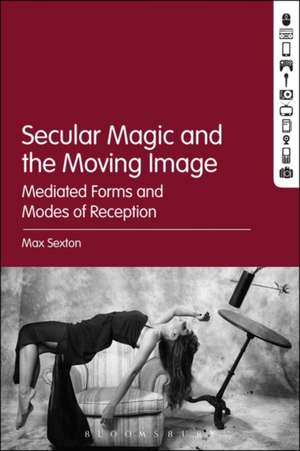Secular Magic and the Moving Image: Mediated Forms and Modes of Reception
Autor Dr. Max Sextonen Limba Engleză Hardback – 13 dec 2017
| Toate formatele și edițiile | Preț | Express |
|---|---|---|
| Paperback (1) | 229.05 lei 43-57 zile | +82.33 lei 5-11 zile |
| Bloomsbury Publishing – 26 iun 2019 | 229.05 lei 43-57 zile | +82.33 lei 5-11 zile |
| Hardback (1) | 715.34 lei 43-57 zile | |
| Bloomsbury Publishing – 13 dec 2017 | 715.34 lei 43-57 zile |
Preț: 715.34 lei
Preț vechi: 1028.14 lei
-30% Nou
Puncte Express: 1073
Preț estimativ în valută:
136.88€ • 143.30$ • 113.26£
136.88€ • 143.30$ • 113.26£
Carte tipărită la comandă
Livrare economică 07-21 aprilie
Preluare comenzi: 021 569.72.76
Specificații
ISBN-13: 9781501320934
ISBN-10: 1501320939
Pagini: 192
Ilustrații: 6 bw illus
Dimensiuni: 152 x 229 mm
Greutate: 0.52 kg
Editura: Bloomsbury Publishing
Colecția Bloomsbury Academic
Locul publicării:New York, United States
ISBN-10: 1501320939
Pagini: 192
Ilustrații: 6 bw illus
Dimensiuni: 152 x 229 mm
Greutate: 0.52 kg
Editura: Bloomsbury Publishing
Colecția Bloomsbury Academic
Locul publicării:New York, United States
Caracteristici
Contributes to debates about medium specificity, specifically the modes of liveness and spectacle, and how the relationship between them has been made more complex by recent medium convergence
Notă biografică
Max Sexton is a lecturer at the University of Surrey, where he currently teaches film and television theory, and an independent scholar. After working in British television, he completed an MA History of Film and Visual Media and a PhD. He is currently interested in the links between aesthetics and technology, the de-stabilization of genre and inter-medial areas between film and television, including debates about the use of live performance and special effects. He co-authored Adapting Science Fiction to Television: Small Screen, Expanded Universe (2015) with Malcolm Cook.
Cuprins
Introduction1. Magic, Mediation, and Television Form2. Magic and Entertainment3. Magic and Performance4. Magic as a Game5. The Magic FilmConclusionFilmographyBibliographyIndex
Recenzii
Sexton's incisive investigation into secular magic on television gives a valuable account of this often ignored popular entertainment. In doing so it provides a gateway to examine and re-evaluate key terms of television studies, including liveness and immediacy, quality, and realism. Going beyond televised magic as a genre, it raises crucial questions about the everyday and the role of mediation in our conception of truth, reality, and identity. Sexton revives neglected magicians like Chan Canasta and David Nixon, provides new insights into the famous work of David Copperfield, David Blaine and Derren Brown, and opens discussion of the next-generation magic of Criss Angel and Dynamo. A consideration of recent Hollywood magic films engages timely questions regarding computer graphics technology and illusion. The arguments made are supported by insightful close analyses of magic performances that reveal how changes in magic and its performance communicate developments film and television history.
Max Sexton's book does more than analyse the representation of magic on television and film, it explores the essence of illusion and how this helps us understand the qualities of these media. This lucid work shows how the performance of magic in-front of the camera disrupts our understanding of the real, and guides us towards a new understanding of authenticity. A fascinating book that uses its focus on 'secular magic' to deliver a remarkable breadth of insight into major issues of television and film studies.
Max Sexton's book does more than analyse the representation of magic on television and film, it explores the essence of illusion and how this helps us understand the qualities of these media. This lucid work shows how the performance of magic in-front of the camera disrupts our understanding of the real, and guides us towards a new understanding of authenticity. A fascinating book that uses its focus on 'secular magic' to deliver a remarkable breadth of insight into major issues of television and film studies.
